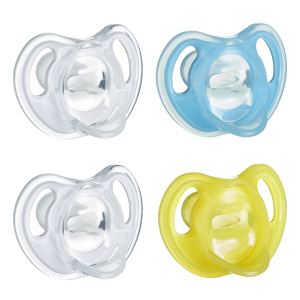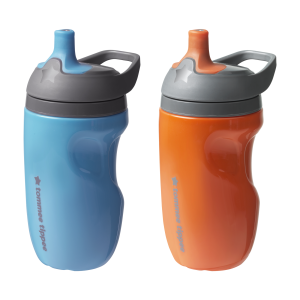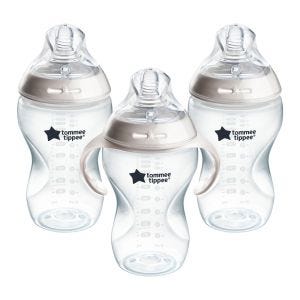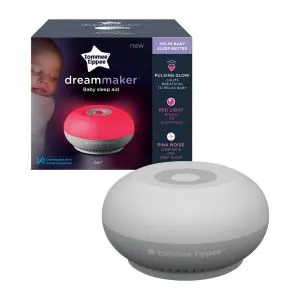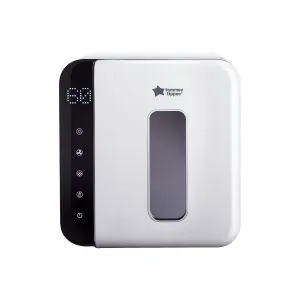
Tommee Tipps
If you're looking to learn more about combination feeding, we’re here to help. Our handy guide will cover everything you need to know before getting started with combination feeding.
Combination Feeding: Bottle and Breast Feeding
The truth is, every parent and baby are different, and so is every baby's feeding journey – with some exclusively breastfeeding or formula feeding, and some combination feeding – each feeding journey is unique. The most important thing is that parents choose the approach that works best for them and their baby’s needs.
When it comes down to breastfeeding and bottle feeding, it’s not a case of one or the other. Parents can get the benefits of both by combination feeding.
Let's cover what combination feeding is, look at its benefits and challenges, and find the answers to some of the most common questions that new parents ask about combination feeding.
What is combination feeding?
Combination feeding – also known as mixed feeding – is when a baby is breastfed and also bottle-fed using either expressed breast milk, formula, or both.
The benefits of combination feeding
Combination feeding offers lots of parents flexibility. It gives other people besides mom the chance to feed the baby using a bottle. It can also be a good option if you have a low breast milk supply, want to supplement with formula for night feeds, or are feeding multiple babies.
Some of the other benefits of combination feeding include:
- Family and friends can be involved in feeding the baby.
- Breast milk has a lot of nutritional benefits for babies and contains antibodies to help protect and boost their immunity, so combination feeding means the baby gets the health benefits of breast milk.
- Mom can get a break and have some freedom away from breastfeeding if she wants.
- It can be handy if you're going back to work and plan on expressing breast milk to be given to your baby in a bottle.
- If you're going away and need to leave your baby, they can still be given breast milk in a bottle by their carer.
- You can monitor how much milk your baby is getting when you use a bottle.
- Feeding using both breast and bottle means that you can still maintain your breast milk supply if you want to continue to pump and directly breastfeed.
Potential challenges of combination feeding a baby
Before you begin combination feeding, you should be aware that bringing a bottle into the mix can sometimes affect the amount of breast milk you produce. Some babies might also take time to adjust to switching between breast and bottle because they need to use a different sucking action when feeding from a bottle.
Don't worry too much though. If you start bottle feeding your baby when they're a little older and you're both comfortable with breastfeeding, and continue to breastfeed and express using a pump frequently, your breast milk supply shouldn’t be impacted.
In addition, some parents find that their babies initially struggle to bottle feed, and the change in their diet when formula is first introduced can sometimes lead to changes in their bowel movements, but this should settle over time.
When to start combination feeding
The American Academy of Pediatrics recommends exclusive breastfeeding for approximately six months after birth, and breastfeeding can help establish a good latch and a steady feeding routine. After this time, you can think about introducing a bottle if you want.
It's recommended that parents wait until their baby is comfortable with breastfeeding before bringing a bottle of breast milk or formula into the mix. You should speak to your health visitor before starting combination feeding.
When you first introduce a bottle:
- Make sure that your baby is happy, relaxed, and not too hungry.
- Ask someone else to give the baby their bottle. Your baby might not feed from a bottle at first if they can sense that your breasts (and breast milk) are close by!
- Try different feeding positions.
- Use a bottle with a breast-like nipple.
- Stay patient and calm. It's normal for a baby to not accept a bottle right away.
How to start combination feeding
You can directly breastfeed and use formula, expressed breast milk in a bottle, or a combination of both to combi feed. This flexibility gives parents lots of room to try out different options and see what works best for them and their baby.
Mixed feeding with expressed breast milk
If you want to combine breastfeeding with bottle feeds of expressed milk, you'll need a breast pump to collect your breast milk to give to your baby in a bottle.
Parents often find that when they express breast milk in the morning, they're able to collect more in a shorter amount of time. But it's also worth noting that expressing at night helps to maintain your long-term milk supply, so try to do both if you can.
It's also important that you carry on breastfeeding or expressing regularly from each boob. If you don’t, there's a chance that your boobs can become painful and engorged.
Mixed feeding with formula
Before introducing formula feeds into your baby's routine, you should speak to your family doctor/and or health visitor.
If you'd like to give your baby formula in a bottle alongside breastfeeding, it’s recommended that you introduce them to formula gradually. Not only does this give time for your body to reduce the volume amount of breast milk it produces but it also allows your little one's digestive system plenty of time to adjust.
If you're introducing formula feeds because you're going back to work, it can help to start combination feeding a few weeks in advance. Establishing a good combination feeding schedule can help you get into the swing of your new routine.
Combination feeding using formula can reduce the quantity of breast milk you produce. So, you should carry on breastfeeding your little one and expressing using a pump regularly to keep your supply going.
Top tips for combined breast and bottle feedings
Combination feeding can come with challenges, but it’s important to find an approach that both you and your baby are happy with.
When reflecting on her feeding journey Danielle says, "[her] son did a little bit of bottle feeding and breastfeeding, but [her] daughter has not been interested in a bottle at all". She believes that "if breastfeeding doesn’t work out for whatever reason, it's ok. If your baby accepts a bottle, go with it. As long as they're getting their milk from somewhere, that’s what really matters".
Jessa and Jaryd told us that "as [they] were preparing for [their] infant feeding journey, [they] had been influenced by societal stigmas surrounding different feeding options. [They] decided that [they] wanted to learn about it more as part of our [their] journey". For them, it was a mixed journey and they implemented both bottle and breast.
Molly said that she "left the hospital in a routine of combine feeding, breastfeeding and formula feeding, and it worked for me and my baby. I was and am still confident that my choice was the best one for the both of us."
And Gianni believes that "regardless of if you nurse directly, pump and feed using a bottle, or formula feed, it is ok. If your baby is healthy, growing and thriving, it is ok".
Successful bottle feeding
Some babies may refuse the bottle initially if they’ve been exclusively breastfed. If this is the case, you may find that the following tips help:
- Don’t force the bottle on your baby and be patient
- Identify their hunger cues early
- Mix breastmilk and formula so your baby recognizes the taste
- Get someone else to feed the baby, so they can’t smell your breast milk
- Warm up the bottle and milk to make the experience more similar to breastfeeding.
If your little one seems to be refusing to feed from their bottle, they've likely become used to feeding directly from your breast.
To help encourage them, you could ask your partner or a friend or family member to give your baby the bottle instead. They'll be less likely to turn away from their bottle if they know your breasts are off-limit.
Maintaining your breast milk supply
Changing to formula feeds as part of your combi feeding journey may affect your breast milk supply, but there are things you can do to maintain a strong supply. These include:
- Regularly pumping or hand expressing.
- Waiting until your baby is confident with breastfeeding before you start combination feeding.
- Introducing formula gradually to avoid a reduced milk supply and potential issues with breast engorgement and mastitis.
Safely using formula
If you choose to formula-feed your baby, you should make sure that:
- The formula you choose is suitable for the age of your baby
- It's not expired
- The packaging is sealed and intact
- It's from a reliable distributor and has been stored correctly.
Combination feeding FAQs
Can you mix breast milk with formula in the same bottle?
Yes, if you follow safe preparation guidelines, you can give your baby a mix of breast milk and formula in the same bottle.
If you decide to do so, you should follow the manufacturer's instructions exactly when preparing the formula, before adding your expressed breast milk. When mixing formula, never substitute water for your breast milk.
- Before preparing a mixed bottle, you should wash your hands and make sure all your feeding equipment is sterilized.
- If you’re combining concentrated liquid or powdered formula with expressed breast milk, you should read the manufacturer’s directions carefully and prepare the formula according. Then once the bottle is ready, you can pour in any of your expressed breast milk.
- If you want to mix your breast milk with ready-to-feed formula, you can pour it into the same bottle as your expressed breast milk right away, because ready-to-serve formula is already prepared.
Can I start combination feeding from birth?
The American Academy of Paediatrics recommends exclusive breastfeeding for approximately six months after birth. But you can introduce combination feeding at any point if that’s what works best for you and your baby, and can continue to breastfeed for as long as you like.
Can I stop combination feeding and go back to breastfeeding?
Yes, if you still have a good breast milk supply, it’s possible to go back to exclusively breastfeeding if you want to. If this move is right for you, you should try to make the change gradually by offering your breast first and reducing the amount of formula you give your baby little by little.
If you're struggling, don't be afraid to ask your midwife, health visitor, or a local breastfeeding support group or lactation consultant for help and advice. Remember, the more you express, the more you'll make. So, continuing to pump and having plenty of skin-to-skin contact with your little one will help to boost your milk supply and encourage them to go back to only breastfeeding.
Sources
- Benefits of Breastfeeding for You & Baby (clevelandclinic.org)
- Combination Feeding and Maintaining Milk Supply | WIC Breastfeeding Support (usda.gov)
- How to Feed a Combination of Breast Milk and Formula - The New York Times (nytimes.com)
- Combining Breastfeeding and Formula Feeding (verywellfamily.com)
- Supplementing With Formula: How to Combo Feed Your Baby (whattoexpect.com)
- Policy Statement: Breastfeeding and the Use of Human Milk | Pediatrics | American Academy of Pediatrics (aap.org)

